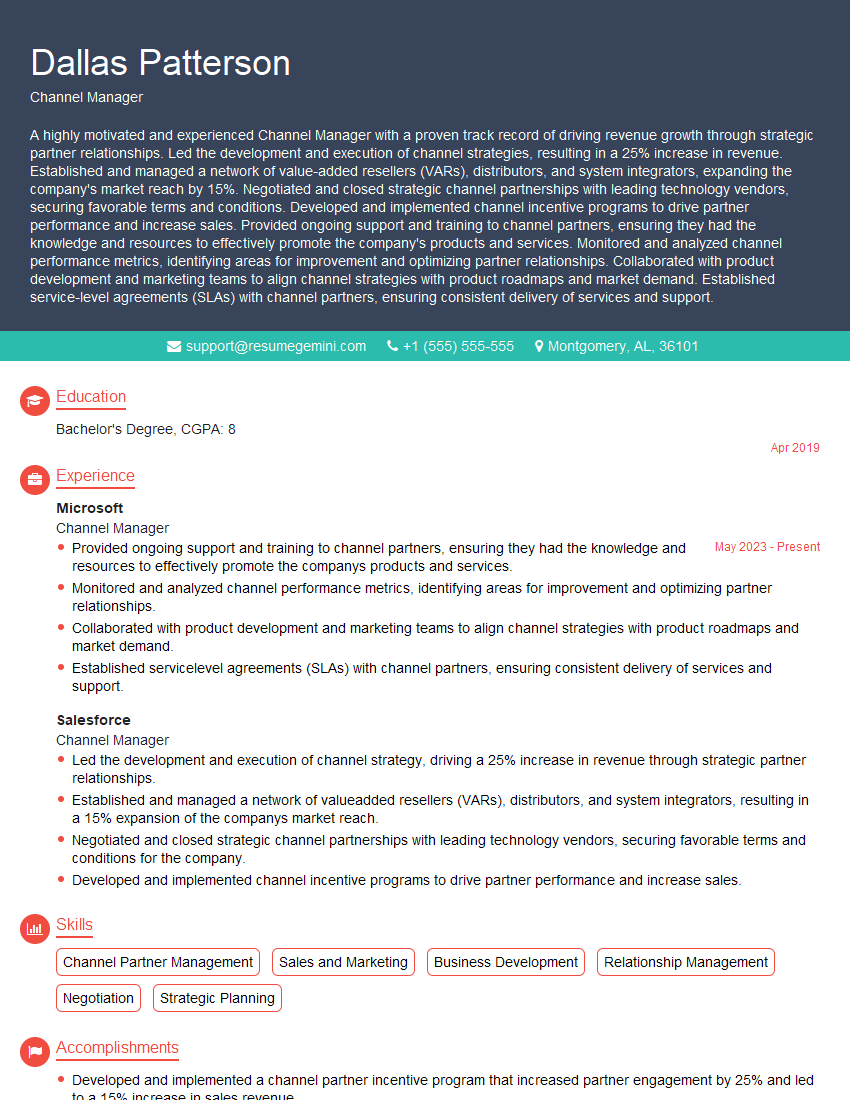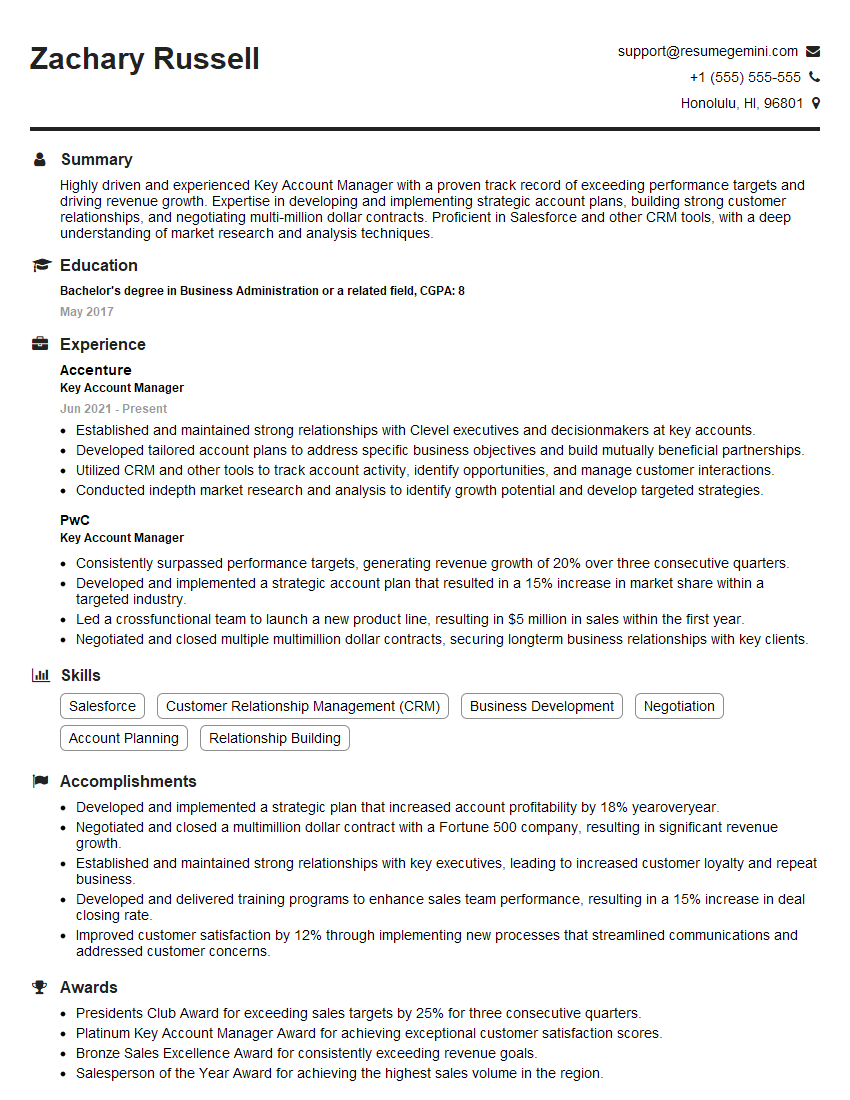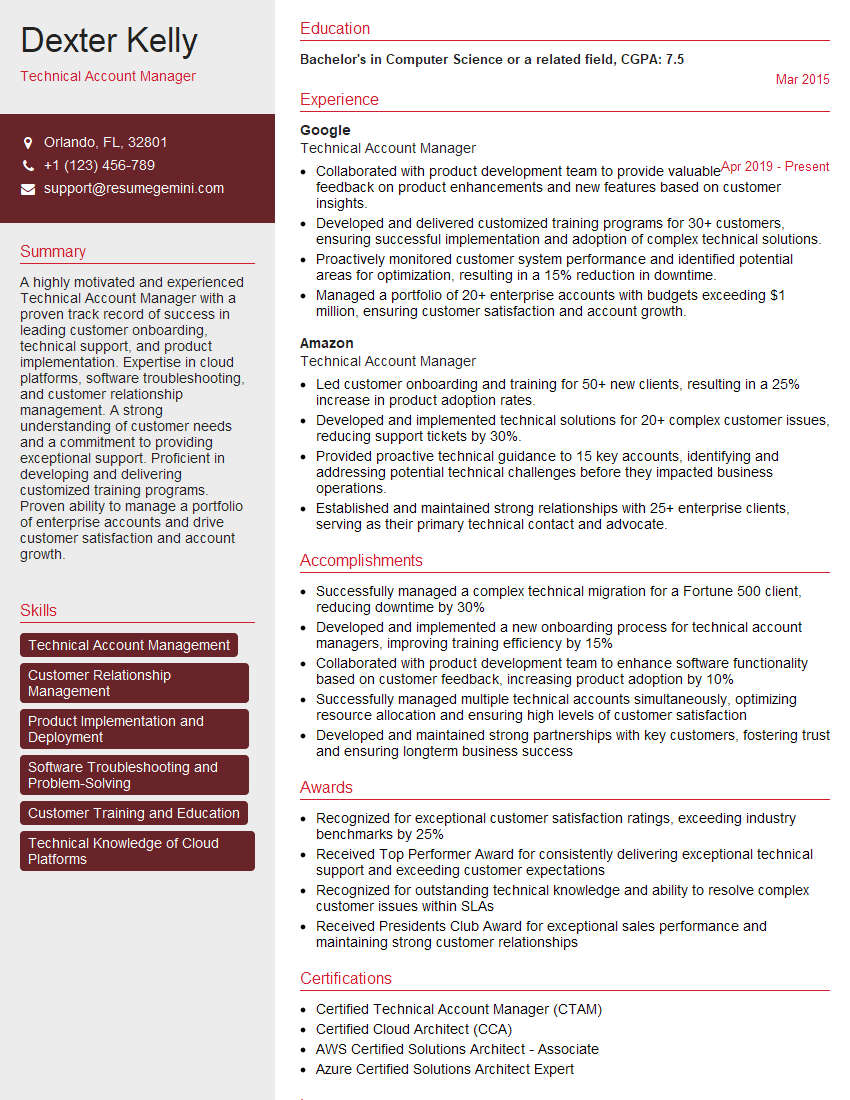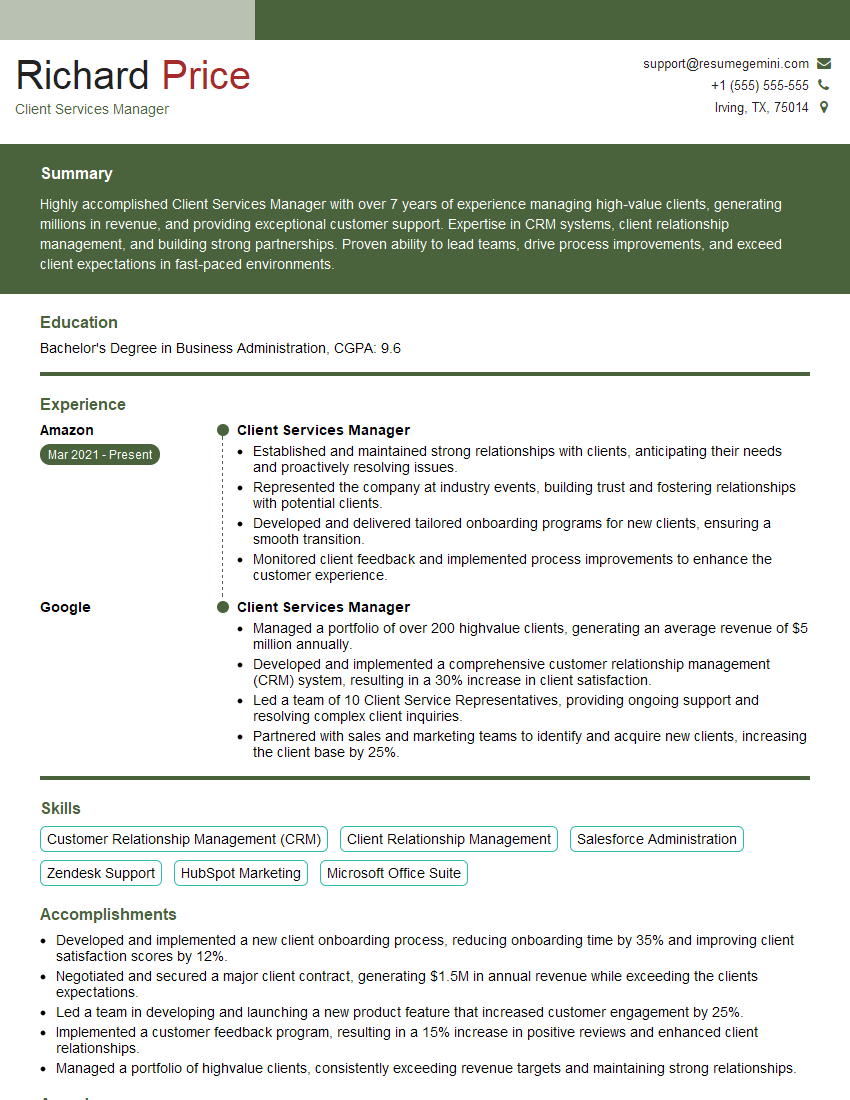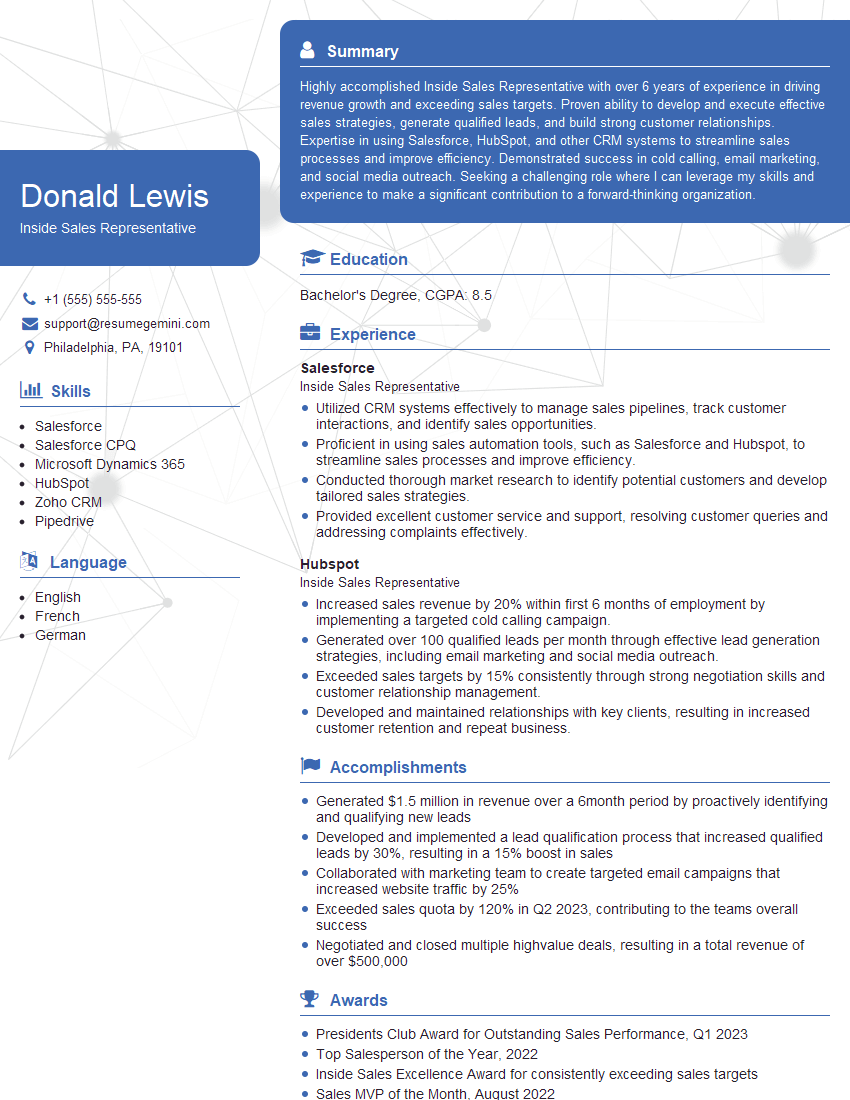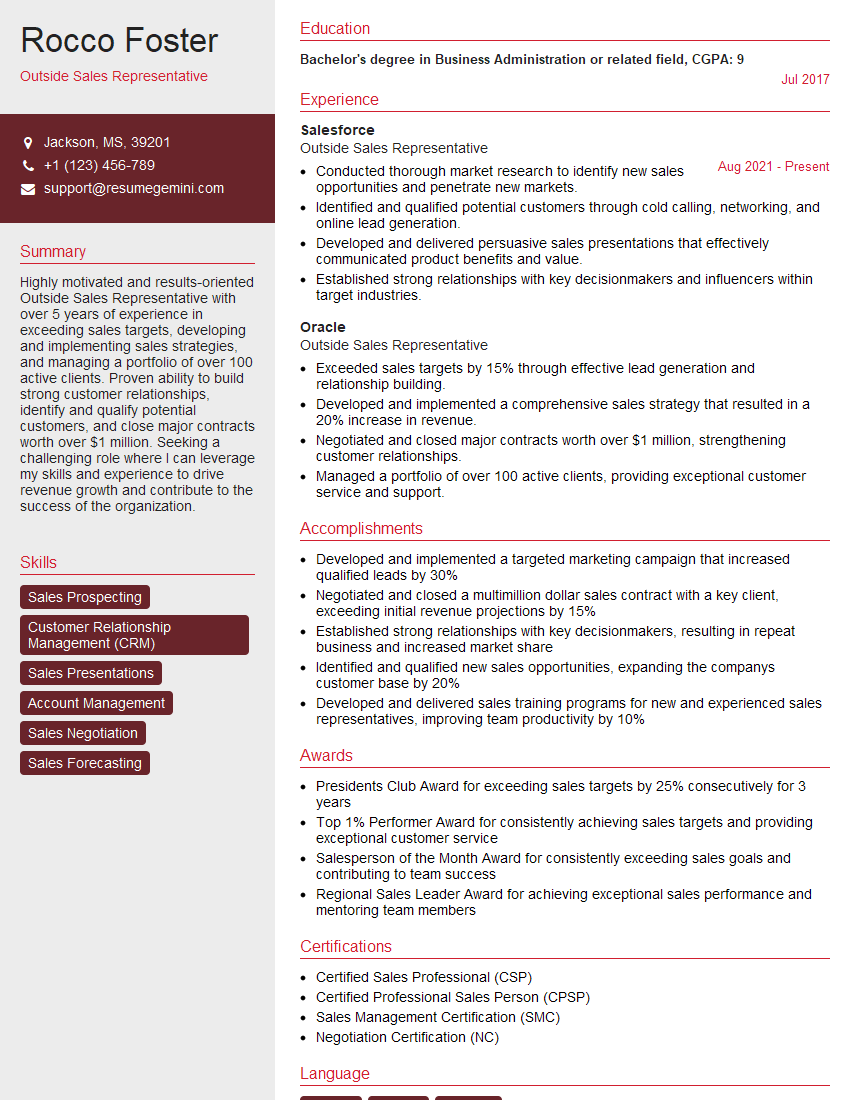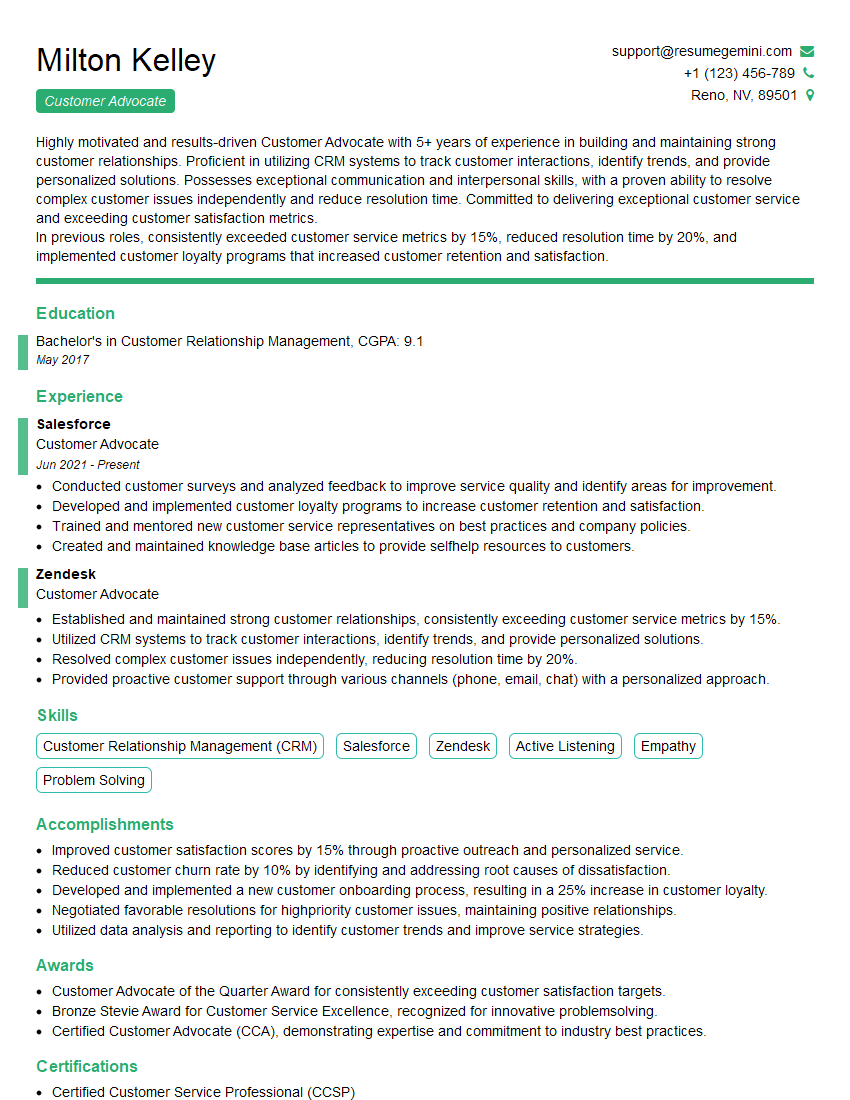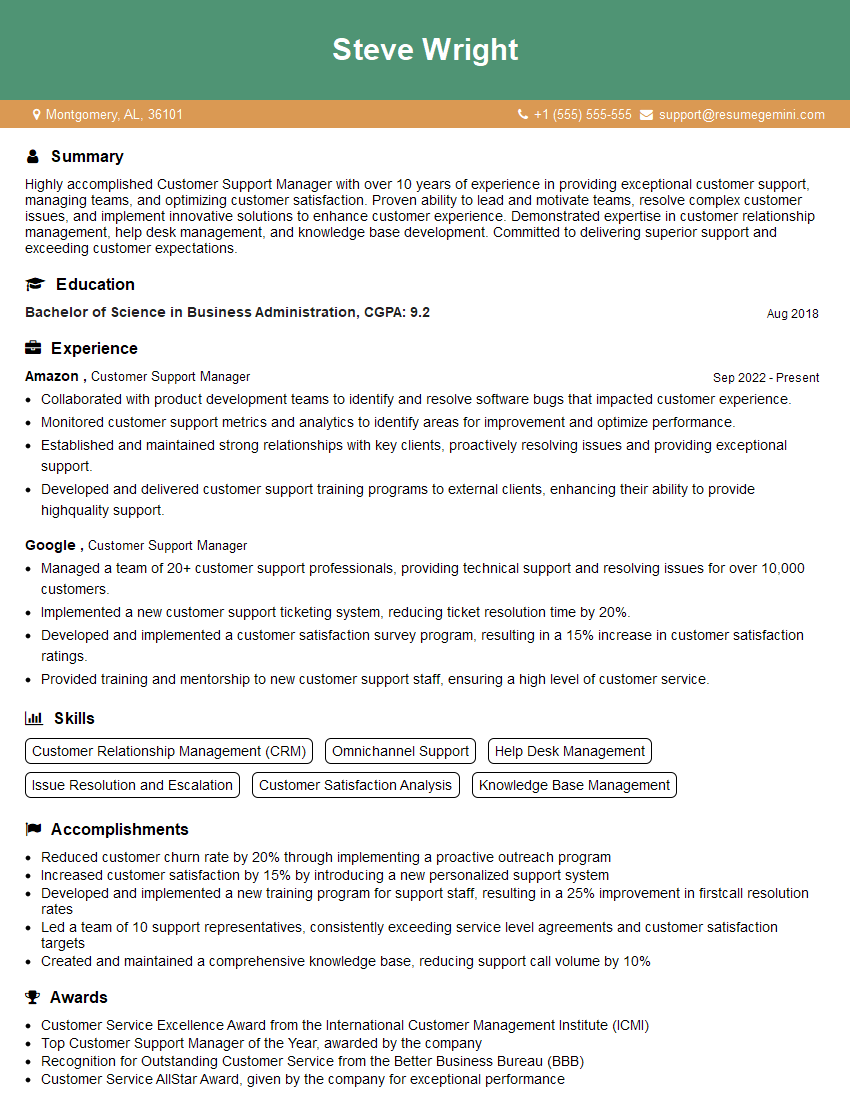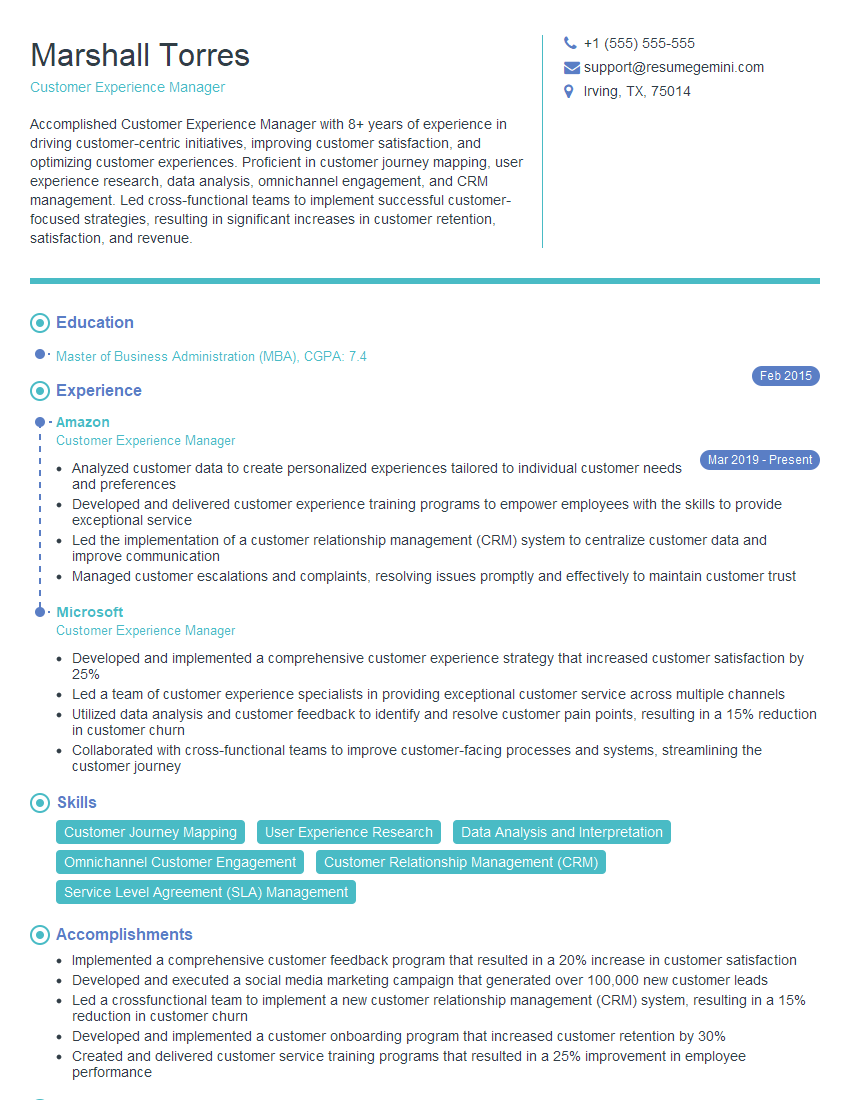Unlock your full potential by mastering the most common Customer Interface and Relationship Building interview questions. This blog offers a deep dive into the critical topics, ensuring you’re not only prepared to answer but to excel. With these insights, you’ll approach your interview with clarity and confidence.
Questions Asked in Customer Interface and Relationship Building Interview
Q 1. Describe your approach to handling a difficult customer interaction.
My approach to handling difficult customer interactions centers around empathy, active listening, and a solution-oriented mindset. I begin by acknowledging the customer’s frustration and validating their feelings. This doesn’t mean agreeing with everything they say, but showing I understand their perspective is crucial. I then actively listen, asking clarifying questions to fully grasp the issue. Avoid interrupting; let them fully express their concerns. Once I understand the problem, I work collaboratively to find a solution. This may involve offering immediate solutions, explaining processes, or escalating the issue to the appropriate team if needed. Transparency is key; I keep the customer informed every step of the way. Finally, I aim to leave the customer feeling heard, understood, and respected, even if the outcome isn’t exactly what they hoped for. For example, if a customer is angry about a late delivery, I wouldn’t immediately jump to excuses but would first acknowledge their frustration and then explain the situation, offering a suitable compensation like a discount or expedited shipping on their next order.
Q 2. How do you build rapport with clients quickly and effectively?
Building rapport quickly involves creating a genuine connection with the client. It starts with a warm and friendly greeting, using their name and making eye contact (if in person or via video call). I focus on active listening, paying attention not just to what they’re saying but also to their tone and body language. I mirror their communication style subtly – if they’re formal, I maintain a professional tone; if they’re more relaxed, I adjust accordingly. Asking open-ended questions allows them to share more information and helps me understand their needs better. Finding common ground, even something seemingly minor, helps build a connection. For instance, if they mention their favorite sports team, I might briefly mention mine (if applicable) to establish a friendly connection. Ultimately, treating them with respect, empathy, and genuine interest goes a long way in creating a strong rapport quickly.
Q 3. Explain your experience with conflict resolution in customer interactions.
My experience in conflict resolution centers on de-escalation and finding mutually acceptable solutions. I’ve handled situations ranging from billing disputes to product defects. My approach always begins with active listening and empathy, seeking to understand the root cause of the conflict from both perspectives. I focus on separating the person from the problem – addressing the issue without making the customer feel personally attacked. I then work collaboratively to brainstorm potential solutions, focusing on what’s feasible and fair. Sometimes this involves compromise, other times it involves explaining policies and processes clearly. I document all interactions and solutions meticulously. For example, I once resolved a conflict between a customer and a technician regarding a faulty product by mediating a call, clarifying the warranty policy, and arranging for a replacement product to be sent. The key is to remain calm, professional, and focus on finding a resolution that both parties feel is fair and just.
Q 4. How do you identify and prioritize customer needs?
Identifying and prioritizing customer needs involves employing active listening, asking probing questions, and carefully analyzing their communication. I often use a combination of direct questioning and observation to uncover both explicit and implicit needs. Explicit needs are those directly stated by the customer, such as needing a product with specific features. Implicit needs are often unspoken but can be inferred through their language, behavior, and priorities. For example, a customer might explicitly request a cheaper product but their implicit needs might include reliability and excellent customer service. I use a prioritization framework based on urgency and impact to determine which needs to address first. Urgent and high-impact needs are addressed immediately, while less urgent needs are scheduled accordingly. This ensures that the most critical needs of the customer are met promptly.
Q 5. What strategies do you use to proactively manage customer relationships?
Proactive customer relationship management involves anticipating customer needs and engaging with them before issues arise. This includes personalized communication, such as targeted email campaigns based on past purchases or website activity. Regular follow-up after a purchase is crucial, ensuring customer satisfaction and addressing any potential problems early on. Building a strong knowledge base of frequently asked questions and solutions reduces the need for reactive responses. Implementing feedback mechanisms—surveys, reviews, and social media monitoring—helps understand ongoing customer needs and expectations. By using CRM software effectively, I can segment customers based on behavior and tailor my communications to their individual needs. For instance, sending personalized birthday wishes or offering exclusive discounts to loyal customers builds long-term engagement and loyalty.
Q 6. Describe a time you went above and beyond for a customer.
I once went above and beyond for a customer who experienced a critical product failure just before a major presentation. The product was essential for their presentation and their deadline was imminent. While technically outside of standard support hours and policies, I personally coordinated with our engineering team to diagnose the issue remotely and expedite a replacement shipment via overnight courier. This ensured the customer had a working product in time for their presentation. This not only solved their immediate problem but also reinforced the value of our customer service and strengthened the relationship. The positive feedback I received was exceptional and demonstrated the significant impact of going the extra mile for a customer in need.
Q 7. How do you handle customer complaints and negative feedback?
Handling customer complaints and negative feedback requires a calm and professional approach. My strategy starts with acknowledging the customer’s frustration and validating their feelings, regardless of whether I agree with their perspective. I then actively listen to understand the details of the complaint, asking clarifying questions without interrupting. Once I understand the issue, I apologize sincerely for the negative experience, even if it wasn’t directly my fault. This doesn’t mean admitting guilt but showing empathy for their frustration. I then work collaboratively to find a solution, offering options and explaining the rationale behind each one. I follow up after resolving the issue to ensure their satisfaction and to gather feedback on my performance. Finally, I document the entire interaction meticulously for future reference and potential improvements in our processes. This ensures I can learn from each experience and prevent similar situations in the future.
Q 8. How do you measure the success of your customer relationships?
Measuring the success of customer relationships goes beyond simple sales figures. It’s about understanding the overall health and value of the relationship. I use a multifaceted approach, tracking key metrics like Customer Satisfaction (CSAT) scores, Net Promoter Score (NPS), customer retention rate, and average revenue per user (ARPU). CSAT measures direct satisfaction with specific interactions, while NPS gauges overall loyalty and willingness to recommend. Retention rate reveals how effectively we retain customers over time, indicating the strength of our relationships. ARPU shows the monetary value each customer brings. Beyond these quantitative measures, I also analyze qualitative data, such as customer feedback from surveys, reviews, and support interactions, to understand the underlying reasons behind the numbers. For example, a high CSAT score but low NPS might suggest a disconnect between immediate satisfaction and long-term loyalty, prompting a deeper investigation into potential issues.
Ultimately, success is defined by a combination of happy, loyal customers who generate consistent revenue and positive word-of-mouth referrals. It’s about building relationships that are mutually beneficial and sustainable in the long run.
Q 9. What tools and techniques do you use to track and manage customer interactions?
Tracking and managing customer interactions requires a robust system. I leverage a combination of tools and techniques, central to which is a Customer Relationship Management (CRM) system. This acts as a central repository for all customer data, enabling a 360-degree view of each interaction. Within the CRM, we track everything from initial contact details and purchase history to support tickets and communication logs. This helps us personalize interactions and anticipate needs. Beyond the CRM, I utilize tools like live chat software for immediate customer support, email marketing platforms for targeted campaigns, and social media monitoring tools to track brand mentions and customer sentiment. I also regularly analyze data from these different sources to identify trends and patterns in customer behaviour. For example, a spike in negative social media comments might indicate a need for immediate action and a review of our processes.
Regular reporting and dashboards help visualize key performance indicators (KPIs) and allow for proactive adjustments to our strategies.
Q 10. How do you personalize your approach to different customer segments?
Personalization is key to building strong customer relationships. I segment customers based on various factors like demographics, purchase history, engagement level, and preferences. For instance, a customer who frequently buys high-end products will receive different communication than a customer who prefers budget-friendly options. This segmentation allows for targeted messaging and offers that resonate with each group. For high-value customers, we might offer personalized recommendations, exclusive promotions, or dedicated account managers. For newer customers, we might focus on onboarding materials and educational content. We use data analytics to continually refine our segmentation and personalize our approach. For example, A/B testing different email subject lines or offers can help identify what resonates best with specific segments.
This personalized approach fosters a sense of value and connection, improving customer loyalty and satisfaction. It’s about showing customers that we understand their individual needs and preferences.
Q 11. Describe your experience using CRM software.
I have extensive experience using various CRM software, including Salesforce, HubSpot, and Zoho CRM. My expertise spans data entry, reporting, customization, and integration with other business tools. I’m proficient in utilizing CRM functionalities such as contact management, lead nurturing, opportunity tracking, and sales forecasting. In previous roles, I’ve been instrumental in implementing and optimizing CRM systems, leading to improved sales efficiency and customer relationship management. For example, in one role, I implemented a new lead scoring system within Salesforce, resulting in a 20% increase in qualified leads.
My experience extends beyond simply using the software; I understand how to leverage its capabilities to drive strategic business objectives. I’m adept at customizing workflows, creating automated processes, and developing reports to track key metrics and monitor performance.
Q 12. How do you maintain positive customer relationships during challenging situations?
Maintaining positive relationships during challenging situations requires empathy, proactive communication, and a commitment to finding solutions. When a problem arises, I prioritize active listening to understand the customer’s perspective and validate their feelings. I avoid defensiveness and instead focus on finding a resolution that satisfies both parties. Transparent communication is crucial; I keep the customer informed about the progress of the situation and manage their expectations realistically. Even if I can’t immediately resolve the issue, I offer alternative solutions or demonstrate a sincere commitment to finding a way forward. For example, if a product is defective, I might offer a replacement, a refund, or a discount on their next purchase, along with a sincere apology.
Turning a negative experience into a positive one can strengthen the customer relationship and build trust. It shows customers that we care about their satisfaction and are willing to go the extra mile to make things right.
Q 13. Explain your understanding of customer lifecycle management.
Customer Lifecycle Management (CLM) is a holistic approach to managing customer relationships throughout their entire journey with a business. It involves understanding the different stages of the customer lifecycle – from initial awareness and acquisition to retention, advocacy, and potentially churn. Each stage presents unique opportunities and challenges, requiring different strategies. For example, during the acquisition phase, we focus on attracting and converting new customers through marketing and sales efforts. During the retention phase, we aim to build loyalty and increase customer lifetime value through excellent service and personalized engagement. Understanding the customer journey allows for more effective resource allocation and targeted interventions at each stage. For instance, a customer exhibiting signs of churn might receive a targeted retention offer or a proactive check-in from a dedicated account manager.
Effective CLM requires a data-driven approach, using analytics to track customer behavior and identify areas for improvement. By understanding the different stages and adapting our strategies accordingly, we can optimize customer experience and build lasting relationships.
Q 14. How do you identify opportunities for upselling or cross-selling to existing clients?
Identifying upselling and cross-selling opportunities requires a deep understanding of customer needs and preferences. I analyze customer purchase history, browsing behavior, and engagement data to identify potential areas for expansion. For instance, a customer who frequently purchases a particular product might be interested in a premium version or a related accessory. Similarly, a customer who has shown interest in a specific product category might be a good candidate for related products within that category. I use the CRM system to track these interactions and identify patterns. Targeted email campaigns, personalized recommendations on the website, and proactive outreach from sales representatives can be employed to present these opportunities. The key is to make the recommendations relevant and valuable to the customer, rather than simply pushing additional products or services. For example, instead of simply suggesting additional products, I might highlight the benefits and value proposition of the upsell or cross-sell, focusing on how it solves a customer’s specific need or improves their experience.
Effective upselling and cross-selling not only increase revenue but also strengthens customer relationships by demonstrating a genuine interest in their needs and providing additional value.
Q 15. How do you manage expectations with clients regarding timelines and deliverables?
Managing client expectations around timelines and deliverables is crucial for building trust and preventing disappointment. My approach is proactive and transparent. It starts with a thorough understanding of the project scope, identifying potential roadblocks, and collaboratively establishing realistic timelines with the client.
- Initial Consultation: I dedicate time upfront to clarify requirements, gathering all necessary information to create an accurate project plan. This involves open dialogue, questioning the client to fully grasp their vision and needs.
- Detailed Project Plan: I create a detailed project plan outlining specific tasks, milestones, deadlines, and responsibilities. This document acts as a shared understanding and a roadmap for the project. I make sure to explain the rationale behind the estimated timelines, highlighting any potential dependencies or risks.
- Regular Updates and Communication: Throughout the project, I provide regular updates, highlighting progress, any challenges faced, and proactively communicating any potential delays. This prevents surprises and allows the client to make informed decisions.
- Contingency Planning: I always build in some buffer time to account for unforeseen issues. This proactive approach allows for flexibility should unexpected problems arise. I also clearly explain to the client the purpose of this buffer.
- Open and Honest Communication: If unforeseen circumstances necessitate a delay, I communicate this immediately and transparently, offering alternative solutions and revised timelines. Honesty and proactive communication are key to maintaining trust.
For example, in a recent web development project, we initially estimated a six-week timeline. However, during the initial design phase, we discovered a critical requirement that was initially overlooked. Instead of hiding this, I immediately communicated the impact on the timeline with the client, proposing alternative solutions to mitigate the delay. We worked together to prioritize tasks and ultimately delivered a slightly revised timeline, maintaining open communication throughout the process.
Career Expert Tips:
- Ace those interviews! Prepare effectively by reviewing the Top 50 Most Common Interview Questions on ResumeGemini.
- Navigate your job search with confidence! Explore a wide range of Career Tips on ResumeGemini. Learn about common challenges and recommendations to overcome them.
- Craft the perfect resume! Master the Art of Resume Writing with ResumeGemini’s guide. Showcase your unique qualifications and achievements effectively.
- Don’t miss out on holiday savings! Build your dream resume with ResumeGemini’s ATS optimized templates.
Q 16. How do you adapt your communication style to different customer personalities?
Adapting communication styles is essential for effective customer relationship building. I believe in understanding different communication preferences and tailoring my approach accordingly. I identify customer personality types through active listening and observation, paying attention to their communication style, body language and the language they use.
- Direct and Decisive (Task-Oriented): For clients who are direct and focused on results, I use concise and efficient communication, focusing on facts, data, and deadlines. I avoid lengthy explanations and get straight to the point.
- Relationship-Oriented: For clients who value building rapport and personal connection, I invest time in building a relationship. I use warm, friendly language, and share relevant personal anecdotes to create a comfortable atmosphere. I prioritize emotional intelligence and understanding their perspective.
- Analytical and Detail-Oriented: For clients who prefer a detailed and thorough approach, I provide comprehensive information and back up my statements with data and evidence. I ensure thorough documentation and a clear explanation of every step of the process.
- Visual Learners: For clients who are visual learners, I utilize visual aids such as graphs, charts, and presentations. This makes the information easily understandable and memorable.
For example, I recently worked with a client who was extremely detail-oriented and preferred thorough documentation. I ensured all communication was documented, providing detailed progress reports, meticulous minutes from our meetings and comprehensive explanations for every decision. This approach built their trust and confidence in our work.
Q 17. Describe a time you had to deal with a demanding or unreasonable customer.
I once dealt with a client who became increasingly demanding and unreasonable as the project progressed. Their requests were constantly changing, and they were consistently pushing back deadlines despite having approved the initial project plan and timelines. The situation was stressful, but I focused on maintaining a calm and professional demeanor.
- Active Listening and Empathy: I started by actively listening to their concerns and trying to understand their perspective, acknowledging their frustration.
- Reiterate the Agreed-Upon Plan: I gently reiterated the previously agreed-upon project scope, timelines, and deliverables, referencing the signed contract and project plan.
- Collaborative Problem Solving: I proposed solutions and compromises, explaining the constraints and the impact of their requests on the timeline and budget. We discussed alternative approaches to meet their needs while respecting project limitations.
- Setting Boundaries: I clearly explained that while I was committed to delivering high-quality work, unreasonable demands and constant changes would impact the project’s success. I firmly but politely reiterated project deadlines and deliverables.
- Escalation When Necessary: When communication broke down, I involved my supervisor. They helped facilitate a more constructive conversation and provided a neutral perspective.
Although the experience was challenging, it taught me the importance of clear communication, setting boundaries, and the value of having a support system when dealing with difficult clients. Ultimately, we found a compromise and successfully delivered a project that, while modified, still met the client’s core needs.
Q 18. What are your strategies for retaining high-value customers?
Retaining high-value customers requires a multi-faceted approach focused on building long-term relationships and exceeding their expectations. It’s about creating a sense of loyalty and demonstrating ongoing value.
- Personalized Service: Offering tailored solutions and remembering specific details about their business and preferences. This demonstrates genuine care and attention.
- Proactive Communication: Regularly checking in, providing updates, and anticipating their needs. This shows that you value their business and are invested in their success.
- Value-Added Services: Offering additional services or benefits that add value beyond the initial agreement. This could include exclusive access to new features, priority support, or personalized training.
- Loyalty Programs and Incentives: Rewarding loyal customers with exclusive discounts, promotions, or rewards. This incentivizes repeat business and creates a sense of exclusivity.
- Feedback and Improvement: Actively seeking feedback and using it to improve products, services, and customer interactions. This demonstrates commitment to continuous improvement and client satisfaction.
- Relationship Management: Assigning a dedicated account manager to build a strong relationship and provide consistent support. This personalized approach fosters trust and loyalty.
For example, we implement a customer success program that involves regular check-ins with our high-value clients, proactively identifying and addressing potential challenges before they escalate. This helps us maintain strong relationships and prevent churn.
Q 19. How do you handle situations where you can’t meet a customer’s request?
Handling situations where I can’t meet a customer’s request requires tact, empathy, and a solution-oriented approach. It’s about managing expectations and finding an acceptable alternative.
- Honest and Transparent Communication: I explain clearly and concisely why I cannot fulfill their request, providing specific reasons without making excuses.
- Empathy and Understanding: I acknowledge their disappointment and validate their feelings, showing empathy for their situation.
- Exploring Alternative Solutions: I actively brainstorm and propose alternative solutions that might meet their needs, even if they’re not exactly what they initially requested. This shows that I am invested in finding a resolution.
- Managing Expectations: I clearly communicate the limitations and trade-offs associated with the alternative solutions. I manage expectations by setting realistic expectations.
- Documentation and Follow-Up: I document the entire process and the agreed-upon alternative solution. I also follow up with the client to ensure they are satisfied with the outcome.
For instance, a client once requested a feature that was not within the capabilities of our current system. I explained the technical limitations clearly, and then proposed a phased approach where we could implement a similar feature in a future release. I also offered alternative solutions within the existing system to partially address their needs. This approach preserved the relationship and led to a mutually acceptable solution.
Q 20. How do you leverage customer feedback to improve processes and products?
Customer feedback is invaluable for process and product improvement. I leverage feedback through structured systems and analysis to identify areas for enhancement.
- Feedback Collection: I utilize various methods to gather customer feedback including surveys, feedback forms, reviews, social media monitoring, and direct customer interactions.
- Feedback Analysis: I categorize and analyze feedback to identify recurring themes, pain points, and areas for improvement. This involves identifying positive and negative feedback.
- Prioritization: I prioritize feedback based on its frequency, impact, and feasibility of implementation. Addressing the most critical issues first is key.
- Implementation and Improvement: Based on the analysis, I work with cross-functional teams to implement changes to processes, products, or services. This often involves updating workflows, developing new features, or improving customer service protocols.
- Measurement and Iteration: I track the impact of implemented changes through key metrics like customer satisfaction scores, retention rates, and sales data. This iterative process allows for continuous improvement.
For example, based on consistent customer feedback about the difficulty of navigating our website, we redesigned the site with a focus on improved user experience. We implemented a more intuitive navigation structure, clearer calls to action, and improved search functionality. The result was a significant increase in customer satisfaction and conversion rates.
Q 21. How do you utilize technology to improve customer communication and service?
Technology plays a crucial role in enhancing customer communication and service. I utilize various tools and platforms to streamline interactions and improve efficiency.
- CRM Systems: I use CRM (Customer Relationship Management) systems to manage customer data, track interactions, and personalize communications. This provides a centralized repository of customer information.
- Help Desk and Ticketing Systems: These systems allow for efficient tracking and resolution of customer issues, ensuring timely responses and follow-up.
- Live Chat and Messaging Platforms: These tools enable real-time customer support, providing instant assistance and enhancing customer satisfaction. This offers immediate support and resolves questions instantly.
- Automated Email Marketing and Notifications: Automated systems send targeted emails for updates, promotions, and reminders. This keeps customers informed and engaged.
- Social Media Monitoring and Engagement: I use social media platforms to monitor customer feedback, address concerns, and engage with customers publicly. This shows that we are responsive and actively listen to our customers.
- Self-Service Portals: Creating a self-service portal with FAQs, tutorials, and knowledge base articles empowers customers to find solutions independently. This reduces the burden on customer support.
For instance, implementing a live chat feature on our website dramatically improved customer support response times and reduced wait times, leading to a considerable boost in customer satisfaction. The improved efficiency and enhanced customer experience significantly increased positive feedback.
Q 22. Describe your experience with different customer communication channels (e.g., email, phone, chat).
My experience spans a wide range of customer communication channels, each with its own nuances and best practices. Email provides a documented record, ideal for complex issues or formal requests. I use clear subject lines, structured content, and always confirm receipt and action. Phone calls offer immediate interaction and allow for nuanced communication, crucial for resolving sensitive or urgent matters. Active listening and empathy are key here; I aim to understand the customer’s perspective fully before offering solutions. Live chat is perfect for quick queries and immediate assistance, requiring concise and efficient responses. I prioritize speed and accuracy, while maintaining a friendly and helpful tone. For example, in a previous role, I streamlined our email response process by implementing templated responses for frequently asked questions, significantly reducing response times without sacrificing personalization. This allowed me to dedicate more time to complex phone calls and chat interactions requiring more in-depth problem-solving.
Q 23. How do you handle customer requests outside of your typical responsibilities?
When faced with a customer request outside my typical responsibilities, my first step is to assess the urgency and nature of the request. If it’s urgent and I have the knowledge to handle it, I’ll address it directly. However, if it falls outside my expertise or requires specialized knowledge, I immediately escalate the issue to the appropriate team member, keeping the customer informed of the process and timeframe. This ensures efficient and accurate resolution without compromising service quality. For instance, if a technical question arises during a sales call, I’ll politely explain that I’ll connect them with our technical support team and introduce them seamlessly. This transparency builds trust and avoids frustrating delays.
Q 24. How do you manage multiple customer accounts effectively?
Managing multiple customer accounts effectively requires a structured approach. I use a CRM system to track interactions, deadlines, and individual customer preferences. Prioritization is crucial; I use methods like urgency/importance matrices to focus on the most critical tasks. Regular reviews of each account help me identify potential issues proactively and ensure consistent service levels. I also utilize automated tools and workflows to streamline repetitive tasks, freeing up time for more complex issues and personalized interactions. Imagine juggling multiple projects – a well-organized calendar, to-do lists, and clear communication with collaborators are essential to success. The same principles apply to managing diverse customer accounts.
Q 25. Explain your understanding of customer segmentation.
Customer segmentation is the process of dividing your customer base into distinct groups based on shared characteristics. This allows for targeted marketing and personalized service. These characteristics can include demographics (age, location, income), behavioral patterns (purchase history, website activity), and psychographics (values, lifestyle). For example, a company selling luxury goods might segment its customers based on income and purchasing behavior, creating targeted campaigns for high-value customers versus those who are new or infrequent buyers. Effective segmentation enhances efficiency and allows for a more impactful and tailored approach to customer engagement.
Q 26. Describe your experience with different customer relationship management methodologies.
I’m familiar with various CRM methodologies, including relationship-based marketing, which prioritizes long-term relationships over short-term gains; and inbound marketing, which focuses on attracting customers organically through content and providing valuable information. I’ve also had experience with account-based marketing, where resources are concentrated on high-value accounts. In practice, I often find that a blended approach is most effective, adapting the methodology to specific customer needs and business objectives. Choosing the right CRM methodology depends heavily on the company’s goals and the nature of its customer base.
Q 27. How do you build trust and credibility with customers?
Building trust and credibility is paramount. It starts with active listening and demonstrating genuine empathy towards the customer’s concerns. Being transparent and honest, even when delivering bad news, is crucial. Following through on commitments and resolving issues promptly further strengthens trust. Consistently exceeding expectations – going the extra mile – shows dedication. For example, proactively identifying and addressing potential issues before the customer notices them demonstrates foresight and care. Building rapport by remembering details from previous interactions helps personalize the experience and makes the customer feel valued.
Q 28. How do you stay up-to-date on the latest trends in customer service and relationship management?
Staying up-to-date requires a multifaceted approach. I regularly read industry publications and blogs, attend webinars and conferences, and actively participate in online forums and communities. Networking with peers and professionals in the field provides valuable insights and best practices. Following thought leaders on social media and subscribing to relevant newsletters keeps me abreast of emerging trends and technological advancements in customer service and relationship management. Continuous learning ensures I can adapt to evolving customer expectations and utilize the latest tools and techniques to enhance customer experience.
Key Topics to Learn for Customer Interface and Relationship Building Interview
- Active Listening & Communication: Mastering the art of truly understanding customer needs and effectively conveying information, both verbally and non-verbally. Consider how you handle diverse communication styles and challenging conversations.
- Empathy and Relationship Building: Developing strong rapport with customers by demonstrating genuine understanding and care for their concerns. Explore strategies for building trust and loyalty.
- Conflict Resolution and Problem Solving: Effectively handling customer complaints and resolving issues in a timely and satisfactory manner. Practice different conflict resolution techniques and approaches.
- Customer Needs Assessment: Proactively identifying customer needs and anticipating potential challenges. Develop your skills in asking insightful questions to uncover underlying requirements.
- Feedback Management and Continuous Improvement: Utilizing customer feedback to enhance service delivery and improve processes. Explore methods for analyzing customer feedback and implementing changes.
- Technology Proficiency: Familiarity with CRM systems and other relevant technologies used in customer interaction. Highlight your experience with specific software or platforms.
- Professionalism and Demeanor: Maintaining a positive and professional attitude in all interactions, even under pressure. Think about examples where you demonstrated composure and professionalism.
Next Steps
Mastering Customer Interface and Relationship Building is crucial for career advancement in today’s competitive landscape. Strong customer relationships are the cornerstone of successful businesses, and your ability to build and maintain them directly impacts your value to any organization. To significantly boost your job prospects, create an ATS-friendly resume that showcases your skills and experience effectively. ResumeGemini is a trusted resource to help you build a professional and compelling resume that highlights your capabilities in this crucial area. Examples of resumes tailored to Customer Interface and Relationship Building are available to guide you through the process.
Explore more articles
Users Rating of Our Blogs
Share Your Experience
We value your feedback! Please rate our content and share your thoughts (optional).
What Readers Say About Our Blog
Hello,
We found issues with your domain’s email setup that may be sending your messages to spam or blocking them completely. InboxShield Mini shows you how to fix it in minutes — no tech skills required.
Scan your domain now for details: https://inboxshield-mini.com/
— Adam @ InboxShield Mini
Reply STOP to unsubscribe
Hi, are you owner of interviewgemini.com? What if I told you I could help you find extra time in your schedule, reconnect with leads you didn’t even realize you missed, and bring in more “I want to work with you” conversations, without increasing your ad spend or hiring a full-time employee?
All with a flexible, budget-friendly service that could easily pay for itself. Sounds good?
Would it be nice to jump on a quick 10-minute call so I can show you exactly how we make this work?
Best,
Hapei
Marketing Director
Hey, I know you’re the owner of interviewgemini.com. I’ll be quick.
Fundraising for your business is tough and time-consuming. We make it easier by guaranteeing two private investor meetings each month, for six months. No demos, no pitch events – just direct introductions to active investors matched to your startup.
If youR17;re raising, this could help you build real momentum. Want me to send more info?
Hi, I represent an SEO company that specialises in getting you AI citations and higher rankings on Google. I’d like to offer you a 100% free SEO audit for your website. Would you be interested?
Hi, I represent an SEO company that specialises in getting you AI citations and higher rankings on Google. I’d like to offer you a 100% free SEO audit for your website. Would you be interested?
good


